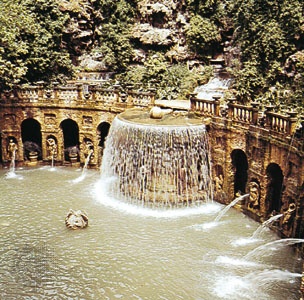Tivoli
Italy
Latin Tibur
 town and episcopal see, Lazio (Latium) regione, central Italy. It is picturesquely situated on the western slopes of the Sabine Hills, along the Aniene River where it enters the Campagna di Roma, just east of Rome. The site commanded the principal natural route eastward from Rome along the Via Tiburtina Valeria and has been continuously occupied since prehistoric times.
town and episcopal see, Lazio (Latium) regione, central Italy. It is picturesquely situated on the western slopes of the Sabine Hills, along the Aniene River where it enters the Campagna di Roma, just east of Rome. The site commanded the principal natural route eastward from Rome along the Via Tiburtina Valeria and has been continuously occupied since prehistoric times.Tivoli was originally an independent member of the Latin League (communities that cooperated in political and social matters) and a rival of Rome, but it passed within the Roman orbit in the 4th century BC. The town received Roman citizenship in 90 BC and attained prosperity as a summer resort under the late republic and early empire. The Roman emperor Augustus and the poets Horace, Catullus, and Sextus Propertius were among its sojourners. Many wealthy Romans built villas and erected small temples in the vicinity of Tivoli. After suffering during the barbarian invasions, the town recovered by the 10th century, became an imperial free city, and maintained its autonomy to some degree until 1816.
Tivoli is an important landmark in the history of architecture, and its monuments are among the most impressive to survive from antiquity; their excavation since the 16th century played a considerable part in shaping successive generations of classicizing taste. Among the remains of wealthy Roman residences in the immediate neighbourhood, the most important are those of the one that was subsequently acquired by the emperor Hadrian in the 1st century to become the nucleus of his famous villa. Hadrian's Villa was the largest and most sumptuous imperial villa in the Roman Empire. It was begun about AD 118 and took about 10 years to build. It lies in a plain below the hill town of Tivoli. The villa contained palaces, libraries, guest quarters, public baths, and two theatres. The remnants of many great brick and concrete structures remain.
 Among other surviving Roman monuments are two small temples and the great temple of Hercules Victor (Ercole Vincitore) within the town, as well as remains of aqueducts and of the poet Horace's Sabine farm nearby. There are also notable medieval landmarks, including the castle (now a prison) built in 1458–64 by Pope Pius II, and the Villa d'Este, begun in 1550 by Pirro Ligorio for Cardinal Ippolito d'Este. The gardens of the Villa d'Este are a magnificent example of Renaissance landscape architecture and are unrivaled in the wealth and fantasy of their fountains; the villa's palace and gardens were designated a UNESCO World Heritage site in 2001. Tivoli's famous waterfalls of the Aniene, 354 feet (108 m) high, have been diminished in volume by hydroelectric projects and other diversions, and indiscriminate building has robbed the old town of much of the charm that made it a favourite resort of artists and travelers during the 18th and 19th centuries.
Among other surviving Roman monuments are two small temples and the great temple of Hercules Victor (Ercole Vincitore) within the town, as well as remains of aqueducts and of the poet Horace's Sabine farm nearby. There are also notable medieval landmarks, including the castle (now a prison) built in 1458–64 by Pope Pius II, and the Villa d'Este, begun in 1550 by Pirro Ligorio for Cardinal Ippolito d'Este. The gardens of the Villa d'Este are a magnificent example of Renaissance landscape architecture and are unrivaled in the wealth and fantasy of their fountains; the villa's palace and gardens were designated a UNESCO World Heritage site in 2001. Tivoli's famous waterfalls of the Aniene, 354 feet (108 m) high, have been diminished in volume by hydroelectric projects and other diversions, and indiscriminate building has robbed the old town of much of the charm that made it a favourite resort of artists and travelers during the 18th and 19th centuries.Tourism along with papermaking and light industry are the chief economic occupations of modern-day Tivoli. Pop. (2001) 49,342.
garden, Copenhagen, Denmark
pleasure garden in Copenhagen. Cafés, restaurants, pavilions, open-air theatres, and an amusement park are scattered among Tivoli's extensive flower gardens. Fireworks, coloured floodlights, and illuminated fountains brighten the park at night; and symphony concerts, jazz and rock shows, pantomimes, and ballets are performed throughout the summer.
The park was opened in 1843 by the writer-architect Georg Carstensen (1812–59) on the southern ramparts of the old city. A remnant of the former moat became a lake for boating. The composer H.C. Lumbye (1810–74) conducted the orchestra at Tivoli for its first 30 years, playing popular Viennese dance music as well as his own compositions. Bombing in 1944 destroyed many park buildings, including the old concert hall; a new concert hall, seating 2,000, was opened in the Tivoli in 1956. It was extensively remodeled in 2005.
- Diego de Saavedra Fajardo
- Diego de Siloé
- Diego de Torres Villarroel
- Diego Duque de Estrada
- Diego Garcia
- Diego Gelmírez
- Diego, Gerardo
- Diego Portales
- Diego Rivera
- Diego Sarmiento de Acuña, Count de Gondomar
- Diego Sarmiento de Acuña Gondomar, Count de
- Diego Velázquez
- Diego Velázquez de Cuéllar
- Diegueño
- Dielasma
- dieldrin
- dielectric
- dielectric constant
- Dielectric constants of some materials
- dielectric heating
- Diels, Otto Paul Hermann
- Diemen, Anthony van
- Dien Bien Phu, Battle of
- Dienes, Valéria
- Dientzenhofer, Christoph